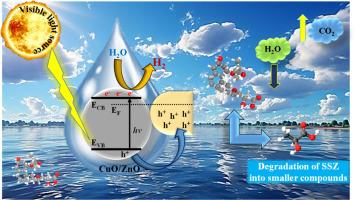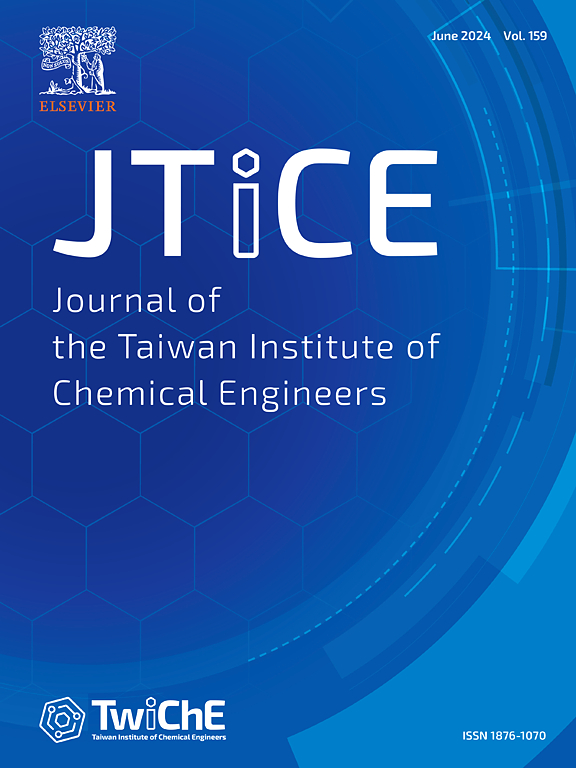利用 CuO/ZnO 二元纳米复合材料进行太阳能驱动的铂自由氢生产和磺胺嘧啶的连续降解:反应动力学和利用响应面方法确定反应参数
IF 5.5
3区 工程技术
Q1 ENGINEERING, CHEMICAL
Journal of the Taiwan Institute of Chemical Engineers
Pub Date : 2024-10-05
DOI:10.1016/j.jtice.2024.105789
引用次数: 0
摘要
背景可持续、绿色和无催化剂制氢的昂贵方法尚未得到广泛探索。此外,在光催化过程中,由于没有适当优化反应参数以去除有毒的工业废水,大量材料被浪费。通过傅立叶变换红外光谱、ZETA 电位、X 射线衍射、扫描电子显微镜、透射电子显微镜、原子力显微镜和 X 射线光电子能谱对合成的光复合材料进行了系统表征。所进行的分析为确定合成光复合材料中的重要官能团、尺寸、形态、元素组成、结晶度和缺陷提供了有用的见解。 重要发现在表征之后,对纳米复合材料进行了光催化磺胺二甲嘧啶(SSZ)降解和制氢评估。采用响应面方法(RSM)对 SSZ 的光催化降解进行了优化。光催化降解 SSZ 的反应参数优化值为:pH = 4.06、SSZ 剂量 = 47.75 mg/L、CuO/ZnO 剂量 = 44.42 mg、温度 = 23.60 °C。观察到的制氢速率(1136 µmolh-1g-1)是在不使用昂贵的辅助催化剂的情况下获得的。制氢的优化值包括光催化剂用量 = 50 毫克、pH 值 = 7、时间 = 5 小时。这些特征表明,合成的纳米复合材料能有效分离电荷载流子,从而产生出色的活性。本文章由计算机程序翻译,如有差异,请以英文原文为准。

Solar-driven Pt free hydrogen production and successive degradation of sulfasalazine using CuO/ZnO binary nanocomposites: Reaction kinetics and determination of reaction parameters using response surface methodology
Background
Approaches for sustainable, green, and expensive catalyst-free hydrogen production have not been explored extensively. Moreover, during photocatalysis, a lot of material gets wasted due to a lack of proper optimization of the reaction parameters to remove the toxic industrial effluents.
Methods
Here in this study, we present the green synthesis of CuO/ZnO nanocomposites from the ethanolic crude extract of Oxystelma esculentum. The synthesized photocomposites were systematically characterized by Fourier transform infrared spectroscopy, zeta potential, x-ray diffraction, scanning electron microscopy, transmission electron microscopy, atomic force microscopy, and x-ray photoelectron spectroscopy. The performed analyses provided useful insights into identifying important functional groups, size, morphology, elemental composition, crystallinity, and defects in the synthesized photocomposites.
Significant Findings
After characterization, the nanocomposites were evaluated for photocatalytic sulfasalazine (SSZ) degradation and hydrogen production. The response surface methodology (RSM) was employed to optimize SSZ's photocatalytic degradation. The optimized values of reaction parameters for the photocatalytic degradation of SSZ comprise pH = 4.06, SSZ dose = 47.75 mg/L, CuO/ZnO dose = 44.42 mg, and temperature = 23.60 °C. The rates observed in the hydrogen production (1136 µmolh-1g-1) were obtained without costly co-catalyst. The optimized values for hydrogen production include photocatalyst dosage = 50 mg, pH = 7, and time = 5 hours. These features signify the efficient separation of charge carriers between synthesized nanocomposites, resulting in exquisite activities.
求助全文
通过发布文献求助,成功后即可免费获取论文全文。
去求助
来源期刊
CiteScore
9.10
自引率
14.00%
发文量
362
审稿时长
35 days
期刊介绍:
Journal of the Taiwan Institute of Chemical Engineers (formerly known as Journal of the Chinese Institute of Chemical Engineers) publishes original works, from fundamental principles to practical applications, in the broad field of chemical engineering with special focus on three aspects: Chemical and Biomolecular Science and Technology, Energy and Environmental Science and Technology, and Materials Science and Technology. Authors should choose for their manuscript an appropriate aspect section and a few related classifications when submitting to the journal online.

 求助内容:
求助内容: 应助结果提醒方式:
应助结果提醒方式:


